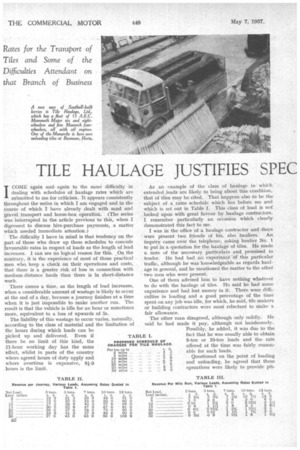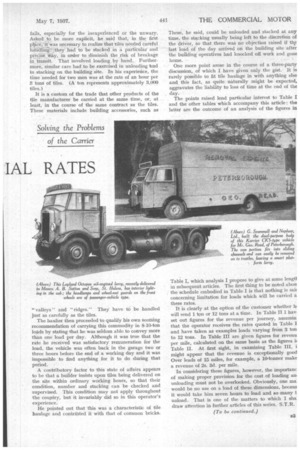TILE HAULAGE JUSTIFIES SPEC
Page 36

Page 37

If you've noticed an error in this article please click here to report it so we can fix it.
ICOME again andagain to the same difficulty in dealing with schedules of haulage rates which are submitted to me for criticism. It appears consistently throughout the series in which I am engaged and in the course of which 1 have already dealt with sand and gravel transport and horse-box operation. (The series was interrupted in the article previous to this, when I digressed to discuss hire-purchase payments, a matter which needed immediate attention.)
The difficulty I have in mind is that tendency on the part of those who draw up these schedules to concede favourable rates in respect of loads as the length of lead increases. I can see no logical reason for this. _On the contrary, it is the experience of most of those practical men who, keep a check on their operations and costs, that there is a greater risk of loss in connection with medium-distance hauls than there is in short-distance work.
There comes a time, as the length of lead increases, when a considerable amount of wastage is likely to occur at the end of a day, because a journey finishes at a time when it is just impossible to make another run. The result is that the vehicle is idle for an hour or sometimes more, equivalent to a loss of upwards of 5s.
The liability of this wastage to occur varies, naturally, according to the class of material and the limitation of the hours during which loads can be picked up and delivered. Even if there be no limit of this kind, the II-hour working day has the same effect, whilst in parts of the country where agreed hours of duty apply and where overtime is expensive, 8i-9 hours is the limit. As an example of the class of haulage in which extended leads are likely to bring about this condition, that of tiles may be cited. That happens also tobe the subject of a rates schedule which lies before me and which is set out in Table I. This class of load is not looked upon with great favour by haulage contractors. I remember particularly an occasion which clearly demonstrated this fact to me.
I was in the office of a haulage contractor and' there were present two friends of his, also hauliers. An inquiry came over the telephone, asking haulier No. t to put in a quotation for the haulage of tiles He made a note of the necessary particulars and promised to tender. He had had no experience of this particular traffic, although he was 'knowledgeable as regards haulage in general, and he mentioned the matter to the other two men who were present.
One of them advised him to have nothing whatever to do with the haulage of tiles. He said he had some experience and had lost money in it. There were difficulties in loading and a good percentage of the time spent on any job was idle, for which, he said, tile makers or building contractors were most reluctant to make a fair allowance.
The other man disagreed, although only mildly. He said he had made it pay, although not handsomely. Possibly, he added, it was due to the fact that he was usually able to obtain 8-ton or 10-ton loads and the rate offered at the time was fairly reasonable for such loads.
LE I.
CH EDULE OF TILE HAULAGE.
Questioned on the point of loading . and unloading, he agreed that these operations were likely to provide pit falls, especially for the inexperienced or the unwary. Asked to be more explicit, he said that, in the first plve, it was necessary to realize that tiles needed careful handling-: they had to be stacked in a particular and precise way, in order to diminish the risk of breakage in transit. That involved loading by hand,. Furthermore, similar care had to be exercised in unloading had in stacking on the building site. In his experience, the time needed for two men was at the rate of an hour per 8 tons of tiles. (A ton represents approximately 3,000 tiles.) It is a custom of the trade that other products of the file manufacturer be carried at the same time, or, at least, in the course of the same contract as the tiles. These materials include building accessories, such as " valleys " and " ridges." They have to be handled just as carefully as the tiles.
The haulier then proceeded to qualify his own seeming recommendation of carrying this commodity in 8-10-ton loads by stating that he was seldom able to convey more than one load per day. Although it was true that the rate he received was satisfactory remuneration for the load, the vehicle was often back in the garage two or three hours before the end of a working day and it was impossible to find anything for it to do during that period.
A contributory factor to this state of affairs appears to be that a builder insists upon tiles being delivered on the site within ordinary working hours, so that their condition, number and stacking can be checked and supervised. This condition may not apply throughout the country, but it invariably did so in this operator's experience.
He pointed out that this was a characteristic of tile haulage and contrasted it with that of common bricks. These, he said, could be unloaded and stacked at any time, the stacking usually being left to the discretion of the driver, so that there was no objection raised if the last load of the day arrived on the building site after the building operatives had knocked off work and gone home. • One more point arose in the course of a three-party discussion,. of which I have given only the gist. It is rarely possible to fit tile haulage in with anything else and this fact, as quite naturally might be expected, aggravates the liability to loss of time at the end of the day.
The points raised lend particular interest to Table I and the other tables which accompany this article : the latter are the outcome of an analysis of the figures in Table I, which analysis I propose to give at some lengff in subsequent articles. The first thing to be noted abou the schedule embodied in Table I is that nothing is sak concerning limitation for loads which will be carried a these rates.
It is clearly at the option of the customer whether hi will send 1 ton or 12 tons at a time. In Table II 1 hay. set out figures for the revenue per journey, assumin that the operator receives the rates quoted in Table I and have taken as examples loads varying from 3 ton to 12 tons. In Table III are given figures for revenu per mile, calculated on the same basis as the figures ii Table II. At first sight, in examining Table III, i might appear that the revenue is exceptionally good Over leads of 15 miles, for example, a 104onner make a revenue of 2s. 3d. per mile.
In considering these figures, however, the importanc of making proper provision for the cost of loading an unloading must not be overlooked. Obviously, one ma would be no use on a load of these dimensions, becaus it would take him seven hours to load and as many t unload. That is one of the matters to which I sha draw attention in further articles of this series. S.T.R.
(To be continued.)




















































































